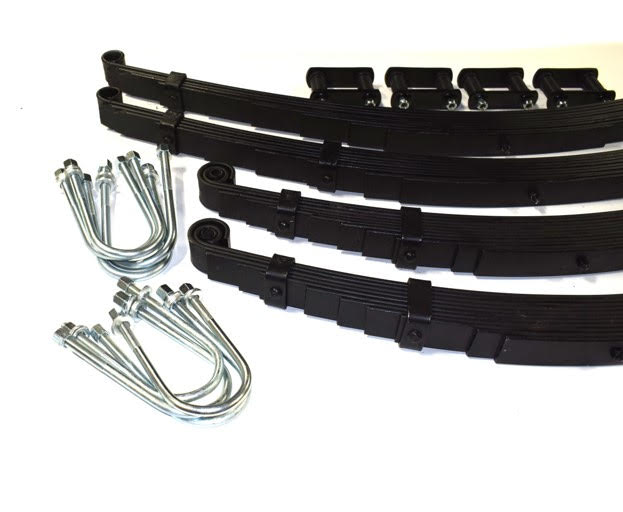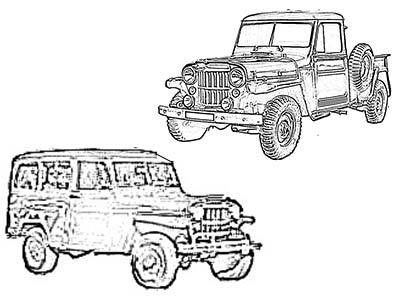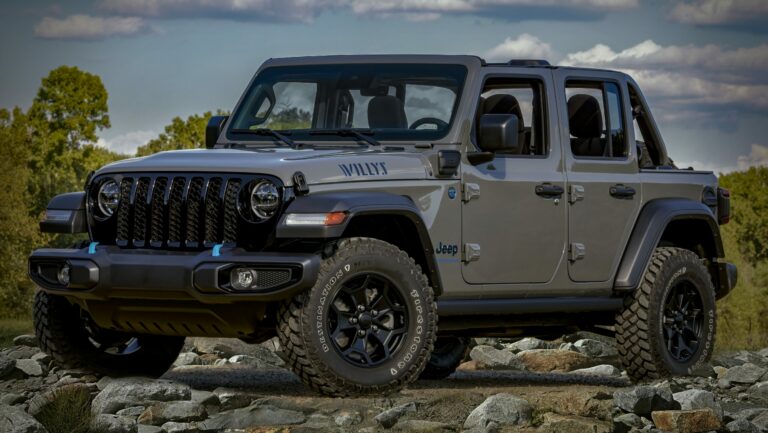1946 To 1964 Jeep Utility Wagon For Sale: A Comprehensive Buyer’s Guide
1946 To 1964 Jeep Utility Wagon For Sale: A Comprehensive Buyer’s Guide jeeps.truckstrend.com
Step into the annals of automotive history, and you’ll discover a vehicle that not only transcended its era but also laid the very groundwork for what we now know as the modern Sport Utility Vehicle (SUV): the Jeep Utility Wagon. Produced from 1946 to 1964, this iconic workhorse, initially by Willys-Overland and later by Kaiser-Jeep, wasn’t just a car; it was a symbol of post-war ingenuity, versatility, and rugged American spirit. For sale today, these vintage wagons offer a unique blend of nostalgic charm, practical utility, and a tangible connection to a pivotal period in automotive design. Whether you’re a seasoned collector, an off-road enthusiast, or simply someone seeking a vehicle with unparalleled character, understanding the nuances of these classic Jeeps is essential before making a purchase.
I. A Legacy of Versatility: Understanding the Jeep Utility Wagon (1946-1964)
1946 To 1964 Jeep Utility Wagon For Sale: A Comprehensive Buyer’s Guide
The story of the Jeep Utility Wagon begins in the immediate aftermath of World War II. Willys-Overland, the primary manufacturer of the military Jeep, recognized the need to transition its wartime production capabilities to civilian applications. The result was the 1946 Willys Jeep Station Wagon, a revolutionary vehicle for its time. Unlike most contemporary "woodie" wagons, the Willys Wagon boasted an all-steel body, making it more durable, safer, and easier to mass-produce. It offered an unprecedented combination of passenger comfort, cargo space, and, crucially, available four-wheel drive (introduced in 1949), making it a true pioneer.
Over its nearly two-decade production run, the Utility Wagon saw several evolutions:
- Willys-Overland Era (1946-1953): These early models typically featured the reliable "Go-Devil" L-head four-cylinder engine, inherited from the military Jeep. They were known for their spartan interiors, robust construction, and utilitarian design. Variants included the standard Utility Wagon, Sedan Delivery (a windowless panel van), and even an ambulance model. The introduction of 4×4 in 1949 cemented its reputation as an unstoppable go-anywhere vehicle.
- Kaiser-Willys / Kaiser-Jeep Era (1953-1964): After Kaiser Motors acquired Willys-Overland in 1953, the wagons continued production with minor updates. Engine options expanded to include the "Hurricane" F-head four-cylinder, and later, the "Supersonic" and "Tornado OHC" inline-sixes, offering more power. While the fundamental design remained, subtle styling changes, interior improvements, and more trim levels emerged, reflecting the growing demand for more comfortable and stylish family vehicles. Despite these changes, the core appeal of rugged reliability and versatility remained.
The Jeep Utility Wagon was a trailblazer, effectively predating the term "SUV" by decades. It served as a family car, a farm vehicle, a commercial delivery truck, and an adventurous off-roader, proving its adaptability in countless roles.
II. Why Buy a 1946-1964 Jeep Utility Wagon Today?

Owning a vintage Jeep Utility Wagon is more than just acquiring a mode of transport; it’s an embrace of history, character, and a unique driving experience.
- Nostalgia & Historical Significance: These wagons represent a significant chapter in automotive history, symbolizing America’s post-war boom and the birth of the SUV. They evoke a simpler time, appealing strongly to those with a fondness for mid-century Americana.
- Unique Design & Character: In a world dominated by anonymous modern vehicles, a vintage Jeep Wagon stands out. Its distinctive grille, upright stance, and utilitarian lines possess an undeniable charm and charisma that turns heads wherever it goes.
- Off-Road Capability (4×4 models): Many of these wagons were equipped with legendary Dana axles and robust transfer cases, making them incredibly capable off-roaders even by modern standards. With proper maintenance and perhaps a few sensible upgrades, they can still tackle challenging terrain with ease.
- Simplicity of Maintenance: Lacking complex computer systems, intricate sensors, and extensive electronics, these vehicles are relatively straightforward to diagnose and repair. For the mechanically inclined, they offer a rewarding opportunity for hands-on maintenance and restoration.
- Investment Potential: Well-preserved or expertly restored examples of the Jeep Utility Wagon have seen a steady appreciation in value over recent years. As iconic pieces of automotive history, their appeal is likely to continue growing, making them a potentially sound investment.
- Customization Potential: From mild patina drivers to full "restomod" builds with modern powertrains and suspension, these wagons are incredibly popular platforms for customization. Their simple architecture lends itself well to personalization, allowing owners to create a vehicle perfectly suited to their vision.

III. What to Look For When Buying: Important Considerations

Purchasing a vintage vehicle requires diligence. Here’s what to scrutinize when eyeing a 1946-1964 Jeep Utility Wagon:
- Rust, Rust, Rust: This is often the primary enemy of any vintage vehicle. Inspect thoroughly for rust in common areas:
- Body Panels: Rocker panels, lower fenders, door bottoms, tailgate, and around window frames.
- Floors: Especially under the front and rear seats, and cargo area.
- Frame: Check for structural rust, cracks, or previous shoddy repairs.
- Roof: Look for bubbling or soft spots, especially on wagons with the ribbed roof.
- Engine & Drivetrain:
- Engines: Be aware of the various engines (Go-Devil L-head 4, Hurricane F-head 4, Supersonic I6, Tornado OHC I6). Check for oil leaks, strange noises (knocks, taps), smoke from the exhaust, and overall running condition.
- Transmission: Most came with a 3-speed manual. Test all gears, check for grinding, difficulty shifting, or popping out of gear. Later models might have an optional automatic.
- Transfer Case (4×4 models): Test engagement of 2WD, 4-high, and 4-low. Listen for excessive noise.
- Axles: Check for leaks around the differential covers and axle shafts.
- Chassis & Suspension:
- Leaf Springs: Look for broken leaves or sagging.
- Shocks: Check for leaks and proper damping.
- Steering: Excessive play in the steering wheel indicates worn components (tie rods, drag link, steering box).
- Brakes: Most are drum brakes. Check for even braking, spongy pedal, or pulling to one side.
- Electrical System: Original systems were 6-volt (later models might be 12-volt). Check all lights, gauges, wipers, and horn. Look for frayed or brittle wiring, which can be a fire hazard. Many have been converted to 12V, which is generally a positive upgrade for reliability.
- Interior & Exterior Condition:
- Glass: Look for cracks, delamination, or fogging.
- Trim & Brightwork: Original trim can be hard to find and expensive to re-chrome.
- Seats & Upholstery: Check for tears, wear, and structural integrity of the frames.
- Dashboard & Gauges: Ensure gauges are functional and the dash isn’t severely cracked or warped.
- Doors & Tailgate: Check for proper alignment and operation. The unique clamshell tailgate design can be prone to wear.
- Documentation: A clear title is paramount. Any service records, original owner’s manuals, or historical documentation add significant value and provide insight into the vehicle’s past.
IV. Navigating the Market: Where and How to Buy
The market for vintage Jeep Utility Wagons is robust but requires a strategic approach.
- Online Marketplaces:
- eBay Motors, Craigslist, Facebook Marketplace: Can offer good deals from private sellers, but require careful vetting and often travel for inspection.
- Hemmings, ClassicCars.com: More specialized classic car sites, often feature higher-quality listings from dealerships or serious collectors.
- Bring a Trailer, Mecum Auctions, Barrett-Jackson: Auction sites that can yield fully restored examples or significant projects, often with detailed photos and community commentary.
- Specialized Forums & Clubs: Online forums (e.g., Willys-Overland-Kaiser Registry, IH8MUD for some 4×4 crossover) and local classic Jeep clubs are excellent resources for finding vehicles, getting advice, and connecting with knowledgeable sellers.
- Classic Car Dealerships: Offer convenience and often some level of pre-vetting, but typically at a higher price point.
- Private Sellers: Often the best source for value, but demand the most due diligence from the buyer.
- Pre-Purchase Inspection (PPI): Regardless of the source, always arrange for a qualified mechanic specializing in vintage Jeeps or general classic cars to perform a thorough PPI. This can save you thousands in unexpected repairs.
V. Restoration vs. Driver vs. Project: Defining Your Purchase
Your budget, mechanical aptitude, and intended use will dictate what type of Jeep Utility Wagon is right for you.
- Fully Restored: These are turn-key, show-quality vehicles. They command the highest prices but offer immediate enjoyment with minimal work required. Ideal for collectors or those who want a pristine example without the time commitment of restoration.
- Good Driver: These wagons are functional, presentable, and generally reliable for regular use. They may have some minor flaws or require small mechanical tweaks, but they are ready to be enjoyed. This offers a good balance of cost and usability.
- Running Project: The vehicle starts and runs but needs significant mechanical, body, or interior work. Priced lower than drivers, they are suitable for enthusiasts with mechanical skills who want to tackle a restoration gradually.
- Non-Running Project/Parts Car: These are the most affordable but require extensive work. They might be missing major components or have severe rust. Best for experienced restorers seeking a ground-up build or for parts to complete another project.
VI. Ownership & Maintenance Tips
Owning a vintage Jeep Wagon is a rewarding experience, but it comes with responsibilities.
- Routine Maintenance: Adhere to regular oil changes, fluid checks (transmission, transfer case, differentials), and lubrication of chassis components.
- Rust Prevention: Keep the vehicle dry, especially in damp climates. Address any new rust spots promptly before they spread.
- Parts Sourcing: While many mechanical parts are available through specialized suppliers (e.g., Kaiser Willys Auto Parts, Walck’s 4WD, Mac’s Auto Parts), body panels and unique trim pieces can be harder to find and expensive. Connect with online communities for leads.
- Community Support: Join online forums and local Jeep clubs. The collective knowledge of other owners is invaluable for troubleshooting, finding parts, and learning best practices.
- Sensible Upgrades: Many owners opt for upgrades like a 12-volt electrical conversion, electronic ignition, power steering, or disc brakes for improved drivability and safety, especially if planning regular use. Engine swaps are also common for more power, but will reduce originality.
Price Table: 1946-1964 Jeep Utility Wagon For Sale
| Condition Category | Estimated Price Range (USD) | Key Characteristics | Considerations |
|---|---|---|---|
| Project Car | $3,000 – $10,000 | Non-running or running with major mechanical/body issues. Significant rust, incomplete, needs full restoration. | Requires extensive mechanical skill, bodywork expertise, and substantial budget for parts/labor. Lowest entry cost. |
| Good Driver | $10,000 – $25,000 | Starts, runs, drives reliably. Presentable appearance with minor flaws. Most systems functional. May need some cosmetic or minor mechanical attention. | Excellent balance for enjoyment and ongoing light restoration. May need attention to rust or worn components over time. |
| Nicely Restored | $25,000 – $45,000 | Professionally restored or very well-maintained original. Minimal rust, good paint, clean interior, reliable mechanicals. Suitable for regular classic car shows or consistent driving. | Higher initial investment. May still require routine maintenance common to vintage vehicles. Quality of restoration varies. |
| Show Quality / Concours | $45,000 – $70,000+ | Flawless, frame-off restoration to original specifications or better. Every detail meticulously addressed. Often rare configurations or exceptionally preserved examples. | Top-tier investment. Primarily for serious collectors or show enthusiasts. Driving may be limited to preserve condition. |
Note: Prices are estimates and can vary wildly based on specific year, engine type (4-cylinder vs. 6-cylinder), 2WD vs. 4WD, originality, regional market demand, and the specific history/documentation of the vehicle.
Frequently Asked Questions (FAQ)
Q: What’s the difference between Willys and Kaiser Jeep Wagons?
A: Willys-Overland produced the wagons from 1946 to 1953. After Kaiser Motors acquired Willys in 1953, production continued under Kaiser-Willys and later Kaiser-Jeep until 1964. While the core design remained similar, Kaiser-era wagons often featured different engine options (like the Hurricane and Tornado OHC), minor styling tweaks, and updated badging.
Q: Are parts readily available for these old Jeeps?
A: Mechanical parts (engine components, drivetrain, brakes, suspension) are generally available from specialized vintage Jeep suppliers. Body panels and unique trim pieces can be harder to find and more expensive, often requiring fabrication or extensive searching.
Q: Can these be daily drivers?
A: While possible, it’s generally not recommended for stock wagons. They lack modern safety features, power accessories (steering, brakes), and climate control. However, many owners convert them with modern engines, transmissions, power steering, and disc brakes to make them more suitable for regular use.
Q: Is 2WD or 4WD more desirable?
A: Four-wheel drive models are generally more desirable and command higher prices due to their enhanced utility, historical significance, and off-road capability.
Q: What are common modifications?
A: Popular modifications include 12-volt electrical conversions, electronic ignition, power steering, disc brake conversions, engine swaps (often V8s or modern inline-fours/sixes), transmission upgrades, and suspension lifts.
Q: How do I get insurance for a classic vehicle?
A: Many insurance companies offer specialized classic car insurance policies. These often have lower premiums than standard auto insurance, but may come with mileage restrictions or requirements for secure storage. Shop around and compare quotes from providers like Hagerty, Grundy, or American Collectors Insurance.
Conclusion
The 1946 to 1964 Jeep Utility Wagon is more than just a vintage vehicle; it’s a testament to a pioneering spirit, a utilitarian design masterpiece, and a foundational ancestor of the modern SUV. For sale today, these enduring wagons offer a unique opportunity to own a piece of automotive history, to experience the simple, robust mechanics of a bygone era, and to join a passionate community of enthusiasts. Whether you envision a meticulous restoration, a reliable weekend cruiser, or a rugged off-road adventurer, the Jeep Utility Wagon stands ready to fulfill your automotive dreams. Its legacy of versatility and durability ensures that these classic Jeeps will continue to captivate and inspire for generations to come.





